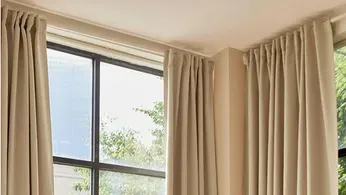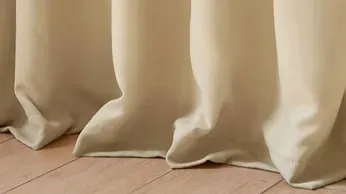
12 hours ago
Thermal Curtain Buyer's Guide: What You Need to Know Before You Shop
READ TIME: 5 MIN.
Thermal curtains represent an easy method to enhance home comfort and energy efficiency. These curtains serve as temperature regulators to manage the indoor climate. This has made them popular among house owners seeking enhanced comfort. TheHues thermal insulated curtains are designed to provide excellent temperature control while adding a stylish touch to any room. Potential buyers need to understand thermal curtains as well as their operating principles before shopping for them.
Understanding the Purpose of Thermal Curtains
The increasing demand for thermal curtains as home comfort and energy efficiency solutions has become a common choice among homeowners. The specially-designed window treatments have functions beyond their appearance. The primary role of thermal curtains is to maintain indoor temperature stability by reducing window heat loss. Such window treatments prove useful in climates that require both heating and cooling because they help control utility expenses. Thermal curtains consist of several fabric layers that incorporate acrylic foam or polyester insulation materials. The multiple layers stop drafts from entering during winter months and prevent summer heat from penetrating inside. Thermal curtains represent an excellent opportunity to enhance a room's comfort level and minimize utility expenses. Several essential criteria need evaluation prior to acquiring a product to guarantee an appropriate selection.
Evaluating Your Insulation Needs
A thorough evaluation of the insulation requirements for each room should be completed before beginning any shopping for stores or online platforms. Every window has different needs regarding thermal protection. A south-facing living room window requires stronger insulation than the shaded window in a guest room. The climate of your home determines whether you need thick or light-weight thermal curtains since colder regions require heavier insulation while warmer areas need lighter blocking options to prevent darkening the room. The decision process needs information about window orientation, together with local temperature patterns and sunlight exposure. Some property owners require thermal drapes in specific spots of their homes, yet others seek total house coverage for constant comfort.
Material Matters: Fabric and Lining
Material selection is an essential factor that determines thermal curtain performance. The choice of fabric material, together with the selection of lining, determines how well the curtains perform. Velvet suede and polyester blends represent popular fabric choices because they naturally create insulation in the home. The lining component stands out as the main determinant for thermal performance. The manufacturing of thermal curtains involves either adding foam backing or implementing multiple layers of acrylic coating. The linings function as barriers that stop both air entry and exit through the window. The lining in certain products gets integrated directly into the curtain fabric, but other products allow users to remove it for cleaning or seasonal adaptation. The quality and type of insulation in a product become clear when buyers examine product descriptions.
Light Control and Room Darkening
Many customers buy thermal curtains because they excel at blocking light from entering rooms. The control of light becomes essential in bedrooms, along with nurseries and media rooms where dark environments are preferred. The thickness of thermal curtains makes them effective at blocking light. When purchasing thermal curtains, consumers need to understand the distinction between "room-darkening," "blackout," and "thermal" product descriptions. A thermal curtain enables light penetration unless manufacturers explicitly design it for blackout purposes. The combination of thermal insulation and maximum light control requires blackout lining or multiple opaque layers in the product selection.

Sizing and Fit: Getting It Right
Thermal curtains need to fit properly to achieve their intended performance. Heat escapes through windows when the window coverings are too short to reach the window edges. Thermal curtain efficiency depends on its proper installation, which extends beyond the window frame by several inches in both vertical and horizontal directions. The curtains need to extend to the floor for maximum insulation, especially when the window opening is large or prone to drafts. Before purchasing thermal curtains, people need to measure their windows precisely. Custom thermal curtains exist for buyers who need special dimensions beyond standard sizes. Thermal curtains layered over blinds or shades improve performance while creating an attractive visual effect in the room.
Energy Efficiency and Cost Savings
The long-term energy savings from using thermal curtains become significant. These curtains protect against heat loss during winter months and summer heat while reducing the amount of work needed from heating and cooling systems. The reduction of energy bills becomes possible through these energy-saving measures. Thermal curtains that are correctly installed by the U.S. Department of Energy can block window heat loss by 25% during winter months. The higher initial cost of thermal curtains becomes worthwhile because they generate significant savings on energy expenses over time. The purchase of thermal curtains presents homeowners with an affordable way to enhance energy efficiency when they avoid spending on new windows.
Maintenance and Durability
The maintenance convenience of these products should be evaluated by potential buyers. The special linings within thermal curtains prevent them from being suitable for machine washing. Thermal curtains need either spot cleaning or dry cleaning methods to maintain their insulation ability. Buyers need to review care instructions before buying since these instructions matter most when installing curtains in busy areas where children and pets live. The durability of thermal curtains depends on the quality standards of their materials. The purchase of premium thermal curtains leads to both enhanced durability and improved insulation performance. Reviews and brand reputation research will give you valuable information about how the product performs throughout its lifespan.
Conclusion
The selection of thermal curtains demands careful consideration of performance features, design elements, and functional requirements. Making final decisions about thermal curtain purchases becomes possible when buyers understand how different features relate to their individual needs. The versatility of thermal curtains makes them an ideal solution for modern homes. It is because they help maintain room temperature during hot and cold seasons and also serve as effective light blockers. Customers should examine multiple products and study customer feedback before buying, while fabric samples serve as an additional helpful resource. The process of buying thermal curtains becomes straightforward and rewarding when you gather the necessary information and develop basic plans, which results in long-term advantages for every season.







